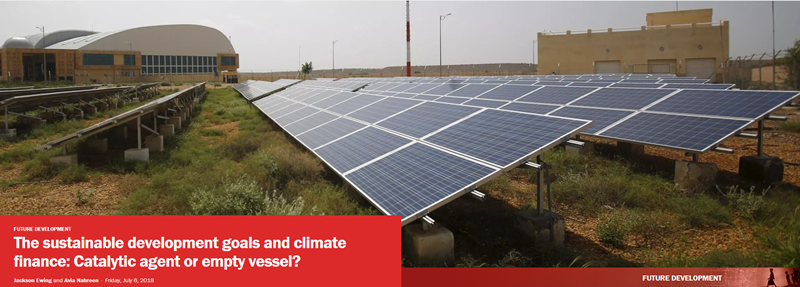
The sustainable development goals and climate finance: Catalytic agent or empty vessel?
Jackson Ewing and Avia Nahreen
Friday, July 6, 2018
Climate change is creating an investment challenge. Although overhauling traditional energy systems, curtailing harmful industry practices, and scaling emerging technology can make economic sense, they often mean steep front-loaded costs. The United Nation’s Sustainable Development Goals (SDGs) are crafted to accelerate the flow of climate finance to developing countries, but, on the surface, it is unclear what new value they bring.
Unlike their Millennium Development Goals (MDGs) predecessor, the SDGs avoid core distinctions between developed and developing countries, opting instead for big-tent commitments that call on the entire international community. Climate finance targets in SDG 13—“take urgent action to combat climate change and its impacts”—are an exception. They call for specific levels of developed and developing country support, emphasizing the need to keep global temperatures in check by prescribing broad-based ways to integrate climate change into development strategies. On clean investment, SDG 13 reinforces a decision made at the United Nations Framework Convention on Climate Change (UNFCCC) to mobilize $100 billion annually by 2020 through the Green Climate Fund (GCF).
MIXED TRENDS IN CLEAN INFRASTRUCTURE
Businesses and financiers have taken a range of approaches to building profitable clean infrastructure, with varying results driven in part by the settings in which they operate. De-risking clean infrastructure and meeting up-front costs often require public incentives and lowered barriers, particularly in developing countries, so the policy context is critical.
Between 2010 and 2016, some $1.7 trillion was invested by private sources as they increasingly took over distressed public infrastructure assets in search of long-term returns. Meanwhile, developed economies have lagged in their commitments to dedicate public funds to mitigate and adapt to climate change. In addition to not being on pace to meet annual infrastructure investment targets in developing states, evidence of predatory loans far higher than the value being transferred, and exaggerations of climate change relevance raise questions about reported climate investment figures.
There are avenues to address these problems. The GCF could provide a global mechanism to steer private and public loans, grants and equity from developed countries toward adaptation and mitigation projects in developing countries. It has approved 54 projects with disbursements of about $1 billion but—as President Donald Trump’s reversal of U.S. commitments demonstrates—it is captive to prevailing political trends and uncertainties about its coffers and capabilities. SDG 13 fetes the GCF in part as a response to this reality, and in doing so seeks to redouble the message that developed countries are on the hook to provide finance that fosters sustainable transitions in the developing world.
Clear messaging about goals, specific targets, and consistent progress reviews are the main instruments for solidifying country-level accountability toward the SDGs. By signing onto the SDGs, the vast majority of the international community has committed to 17 goals and 169 targets. However, there is no punitive action or significant international censure for those who shirk or renege. The SDGs and MDGs before them are only as powerful as their reputations, platforms, and the ability of their leaders to drive change. The SDGs—like nascent approaches at the UNFCCC—are based on doggedly negotiating goals and following up with years of diplomatic peer pressure from international and country-level champions. They will have material relevance to climate finance needs only if they foster levels of accountability commensurate with their goals.


































